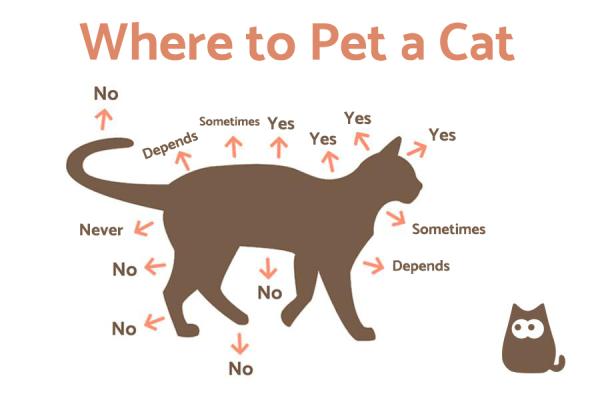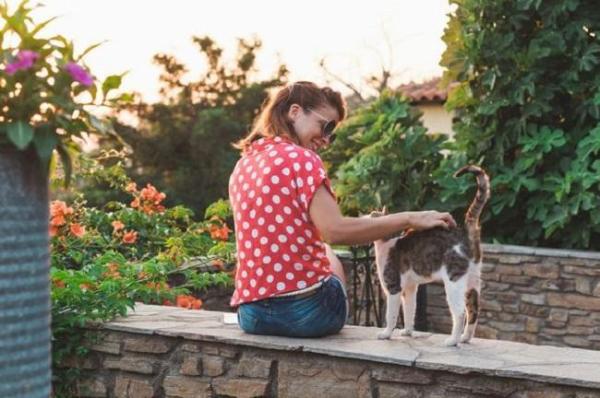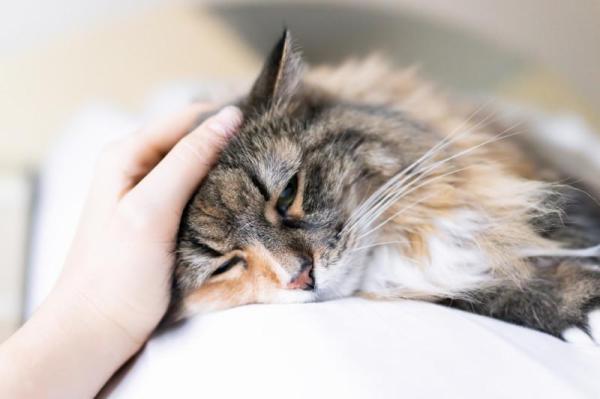The Best Places to Pet a Cat - How to Pet Properly



See files for Cats
When we see a cat, the first thing we want to do is pet them. They are adorable creatures with a soft coat, not to mention the fact that petting cats has been known to reduce stress in humans. It may be surprising to know that even cat guardians don't always know how to pet a cat properly. The result can be an annoyed cat, scratches to the hand and even a weakening of the bond between the feline and guardian.
While some cats may react badly for their own reasons, it is often the case that humans don't recognize the warning signs the cat is giving. This is why AnimalWised shares this article on the best places to pet a cat and how to pet a cat properly. We also show you where not to pet a cat and how you can tell what they like and don't like.
What is the best way to pet a cat?
The domestic cat (Felis silvestris catus) was originally a solitary animal, something which harks back to their wild ancestry. Centuries of domestication has lead to alterations in the behavior of this species. How tolerant an individual cat will be of human companionship will depend on various factors. Genetics, breed, socialization and past experiences are the main influences, but each cat is an individual.
In a general sense, it can be said that cats dislike excessive manipulation. This is why learning to interpret feline body language is so important. It not only lets us know our cat better, it can let us know their tolerance threshold and encourage better communication between the two of us.
Some of the signs a cat is happy include:
- Relaxed body posture
- Erect ears
- Raised tail and head
- Secure gait
- ‘Vibrating’ tail
When you identify these postures in your cat, you should be able to tell they are relaxed, receptive and ready to be petted. However, you should also bolster their confidence by offering a relaxed atmosphere, using a gentle and soft tone of voice and making slowly progressive movements.
Letting the cat initiate the petting is essential when beginning the petting process. You may need to approach them, but if it feels like you are forcing interaction it can lead the cat to feel trapped. Remain attentive to their body language and pay attention to any symptoms of displeasure. When they decide the petting session has finished, they will get up of their own accord. It is important we always respect their boundaries.
Where to pet a cat
Now you know the basic premises of how to do it properly, we can reveal the best places to pet a cat. These are areas most cats prefer, discovered through countless hours of interactions. Even so, each cat is different and there will be places one cat might enjoy being petted which are off limits for others. As each cat has their own preferences, getting to know your feline friend takes time and patience.
The first thing to remember when petting a cat is that it is imperative you go along the line of their fur. Never go against the grain. The ideal is to softly go in the direction in which the cat's hair grows without patting, hitting or pinching. Even if we are trying to be encouraging, our movements can be too violent for an animal over 20 times smaller than we are. In these first petting sessions, it is important to be as careful and affectionate as possible.
We start with their head and use the tips of our fingers like a ‘comb’. Stroke our fingers on the top of their head and down their neck. We can also massage the upper and middle part of the cat's back, starting with the scapulae and ending near the thoracic vertebrae (i.e. from the shoulder to the bottom of their rib cage). Similarly, we can gently scratch their cheeks or underneath their chin. These areas might provoke insecurity in the cat, often being reserved only for those to whom they feel close.
Avoid stroking the cat's belly, tail, legs or paw pads. Cats often find these areas unpleasant when touched. If we do touch them, we might see signs of displeasure ranging from withdrawing from the petting or putting their ears back. If we ignore the warnings the cat is giving us, they may raise the intensity of the warnings with a scratch or a bite.
Signs of an angry or unhappy cat include:
- Tense body posture
- Ears folded back
- Bristled tail
- Tail whipping side to side
- Fast tail movement
- Fast general movement
- Bristled coat
- Arched body
- Open mouth
- Hissing
- Growling
If we observe any of the above signs, we should stop immediately. In fact, we should never get to the stage that a cat is giving off these signals. This is why it is so important to begin the petting process gradually and better understand the limits of their tolerance. In our petting sessions with our cats, we should also ensure they are positive experiences. This means paying careful attention to their preferences and responses.

How to pet a cat to sleep
Many people want to know how they can pet a cat to fall asleep. It's not that we should enforce sleep on our cats, but they can get a little anxious or rambunctious and helping them to relax can be beneficial. Sleep is a necessity for cats, especially in early developmental stages. Without proper sleep, their health and well-being can be seriously affected.
To help a cat relax and eventually fall asleep, the ideal is to provide soft and long caresses. Ensure they are in a position where it is beneficial for them to sleep. Don't do it when the cat is on your lap as you may need to get up after they fall asleep and you ruin your good work. Create an environment conducive to sleep. This means:
- Comfortable resting place
- Warm (not hot) temperature
- Quiet
- Low lit
Start at their head and work your way down their back. Long, slow petting will help them relax and stretch out into a comfortable position. Don't do it constantly. Instead, take short pauses, especially if you see them start to get agitated. Most importantly, don't force them to sleep. If they are not ready and they get up to leave, forcing them to stay can be traumatic and negatively affect your bond.
How to pet a mean cat
While we might be wondering how to pet a cat, the mental state of the feline needs to be considered. A cat may be permanently mean and difficult to get along with. Similarly, they might have mood swings and be surly at some points more than others. If we have gone to the vet and know that their meanness is not caused by a pathological issue, then we may just have to be careful on our approach.
In no case should we punish or scold the cat for not wanting to be petted. In fact, if we notice that our cat is being particularly bad-tempered, is scared of petting, rejects contact or even becomes aggressive, we need to consider whether they are stressed.
Neither should we bother the cat when they are relaxed, asleep or distracted. If we try to force petting on them at this time, we might be the one who is adding stress to their daily routine. Neither should we make sudden movements or noises as this can only make them meaner.
In shy, scared or mean cats, we should always handle them smoothly, positively, gradually and confidently. We should avoid the prohibited areas we have discussed above and only use positive reinforcement to ensure they are in a positive state. Speaking softly and reassuringly will help and it is not a bad idea to have some treats at hand.
In more serious cases, the meanness of your cat might be due to poor socialization or past trauma. This is something which may require a professional to help with. A feline ethologist or cat trainer can help provide some practical ways to help reassure the cat and reduce behavioral problems. If we don't, stress can lead to further physiological problems as well as psychological ones.
How to pet a stray cat
To begin with, we need to differentiate between different types of ‘street cats’. The two main types are:
- Feral cats: these are felines who may come from domestic cat breeds, but have never been socialized with humans.
- Stray cats: these are cats which have been born into a domestic setting, but for whatever reason have become lost and end up without guardians. These cats may have become lost or even abandoned by irresponsible owners.
Feral cats will be very unlikely to accept contact from people and may lash out aggressively at any attempts. Not only that, but they might carry disease or parasites, so we need to be extra careful. Stray cats might be more inclined to accept physical contact, especially if they believe there might be a chance of getting food.
If we do want to pet a stray cat, we should let them first sniff our hand so they can identify us. In this way, they can feel more comfortable in our presence. If they do not show interest, do not force the situation. Once again, we need to pay careful attention to their body language.
If we observe positive responses, for example if they rub their head against us or demand attention, then we can try to pet them with caution. Use slow and smooth movements. Be careful if we hear a slight purr. While this may indicate enjoyment, it can also be a sign of discomfort.

How to pet a kitten
Petting a kitten will depend on their age and ability. If they are newborn kittens, we should be handling them minimally. They are vulnerable to disease and they need this time to grow and be cared for by their mother. If we interfere too much, it can upset their equilibrium and be stressful for their mother. Once they start to open their eyes and walk, then they are going to need to explore their environment. This includes you.
Petting a kitten should be relatively easy since they will have slow movement and depend on others for their security. However, this stage is also very important in developing their personality and well-being. We need to show them positive interactions and petting them is a big part of this. If they do not learn how to accept this behavior at a young age, they may reject it when they are an adult.
One particularly good way to pet a kitten is to find a soft pillow or cushion. Let them come over and lay down on it. When they do, you can give them a slow and soft five minute massage. If they want to start playing, then stop the massage and let them settle down again. Repeat this a couple of time a day and you will start to see they associate the pillow with relaxing times. It can help them get to sleep and understand when is a good time to play and when is a good time to relax.

The benefits of petting cats
To finish, we should reiterate that petting a cat has many benefits not only for the cat, but for ourselves. According to various studies [1] [2] [3], petting cats positively affects both our mental and physical health. They can even help reduce the risk of heart attack by 30%.
Similarly, the benefit it has on our mind might be surprising. People who pet cats regularly it is claimed can communicate better, have a greater capacity for concentration and generally be more engaged. They can also be very beneficial for people with mood disorders as petting cats can greatly help relieve anxiety disorders.
For the cat, the benefits are similar. A cat which allows us to pet them is a cat which has confidence in their relationship to humans. It implies a strong bond and a sense of security. If you have any experiences or tips on how to pet a cat properly, please feel free to share them in the comments below.

If you want to read similar articles to The Best Places to Pet a Cat - How to Pet Properly, we recommend you visit our Basic care category.
1. Rahman, M. S. (2015). Health Benefits from Companion Animals. Microbes and Health, 4(1), 1-3.
2. Beck, A. (2000). The Use of Animals to Benefit Humans: Animal-Assisted Therapy. Teoksessa Fine, A.(toim.) Handbook on Animal-Assisted therapy, theoretical foundations and guidelines for practice.
3. Catharine Paddock PhD. (Monday 25 February 2008). Cat Owners Have Lower Heart Attack Risk, Study. 2019, from Medical News Today: https://www.medicalnewstoday.com/articles/98432.php
- Turner, D. C., Bateson, P., & Bateson, P. P. G. (Eds.). (2000). The domestic cat: the biology of its behaviour. Cambridge University Press.
- Crowell-Davis, S. L., Curtis, T. M., & Knowles, R. J. (2004). Social organization in the cat: a modern understanding. Journal of feline medicine and surgery, 6(1), 19-28.
- Turner, D. C. (2000). 10 The human-cat relationship. The domestic cat: the biology of its behaviour, 193.









